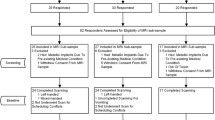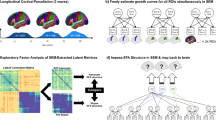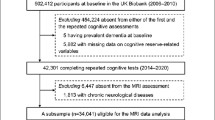Abstract
The objective of this work was to test the hypotheses that a) more frequent cognitive activity in late life is associated with higher brain diffusion anisotropy and lower trace of the diffusion tensor, and b) brain diffusion characteristics partially mediate the association of late life cognitive activity with cognition. As part of a longitudinal cohort study, 379 older people without dementia rated their frequency of participation in cognitive activities, completed a battery of cognitive function tests, and underwent diffusion tensor imaging. We used tract-based spatial statistics to test the association between late life cognitive activity and brain diffusion characteristics. Clusters with statistically significant findings defined regions of interest in which we tested the hypothesis that diffusion characteristics partially mediate the association of late life cognitive activity with cognition. More frequent cognitive activity in late life was associated with higher level of global cognition after adjustment for age, sex, education, and indicators of early life cognitive enrichment (p = 0.001). More frequent cognitive activity was also related to higher fractional anisotropy in the left superior and inferior longitudinal fasciculi, left fornix, and corpus callosum, and lower trace in the thalamus (p < 0.05, FWE-corrected). After controlling for fractional anisotropy or trace from these regions, the regression coefficient for the association of late life cognitive activity with cognition was reduced by as much as 26 %. These findings suggest that the association of late life cognitive activity with cognition may be partially mediated by brain diffusion characteristics.



Similar content being viewed by others
References
Arfanakis, K., Fleischman, D. A., Grisot, G., Barth, C. M., Varentsova, A., Morris, M. C., et al. (2013). Systemic inflammation in non-demented elderly human subjects: brain microstructure and cognition. PLoS ONE, 8, e73107.
Bennett, D. A., Schneider, J. A., Aggarwal, N. T., Arvanitakis, Z., Shah, R. C., Kelly, J. F., et al. (2006a). Decision rules guiding the clinical diagnosis of Alzheimer’s disease in two community-based cohort studies compared to standard practice in a clinic-based cohort study. Neuroepidemiology, 27, 169–176.
Bennett, D. A., Schneider, J. A., Arvanitakis, Z., Kelly, J. F., Aggarwal, N. T., Shah, R. C., et al. (2006b). Neuropathology of older persons without cognitive impairment from two community-based studies. Neurology, 66, 1837–1844.
Bennett, D. A., Schneider, J. A., Buchman, A. S., Barnes, L. L., Boyle, P. A., & Wilson, R. S. (2012). Overview and findings from the rush memory and aging project. Current Alzheimer Research, 9, 646–663.
Blumenfeld-Katzir, T., Pasternak, O., Dagan, M., & Assaf, Y. (2011). Diffusion MRI of structural brain plasticity induced by a learning and memory task. PLoS ONE, 6, e20678.
Boyle, P. A., Wilson, R. S., Aggarwal, N. T., Tang, Y., & Bennett, D. A. (2006). Mild cognitive impairment: risk of Alzheimer’s disease and rate of cognitive decline. Neurology, 67, 441–445.
Bucur, B., Madden, D. J., Spaniol, J., Provenzale, J. M., Cabeza, R., White, L. E., et al. (2008). Age-related slowing of memory retrieval: contributions of perceptual speed and cerebral white matter integrity. Neurobiology of Aging, 29, 1070–1079.
Buschkuehl, M., Jaeggi, S. M., & Jonides, J. (2012). Neuronal effects following working memory training. Developmental Cognitive Neuroscience, 2(Suppl 1), S167–179.
Chanraud, S., Zahr, N., Sullivan, E. V., & Pfefferbaum, A. (2010). MR diffusion tensor imaging: a window into white matter integrity of the working brain. Neuropsychology Review, 20, 209–225.
Chapman, S. B., Aslan, S., Spence, J. S., Hart, J. J., Jr., Bartz, E. K., Didehbani, N., et al. (2015). Neural mechanisms of brain plasticity with complex cognitive training in healthy seniors. Cerebral Cortex, 25, 396–405.
Engvig, A., Fjell, A. M., Westlye, L. T., Moberget, T., Sundseth, Ø., Larsen, V. A., et al. (2012). Memory training impacts short-term changes in aging white matter: a longitudinal diffusion tensor imaging study. Human Brain Mapping, 33, 2390–2406.
Ghisletta, P., Bickel, J. F., & Lövdén, M. (2006). Does activity engagement protect against cognitive decline in old age? Methodological and analytical considerations. Journals of Gerontology. Series B, Psychological Sciences and Social Sciences, 61, 253–261.
Gow, A. J., Bastin, M. E., Muñoz Maniega, S., Valdés Hernández, M. C., Morris, Z., Murray, C., et al. (2012). Neuroprotective lifestyles and the aging brain: activity, atrophy, and white matter integrity. Neurology, 79, 1802–1808.
Hall, C. B., Lipton, R. B., Sliwinski, M., Katz, M. J., Derby, C. A., & Verghese, J. (2009). Cognitive activities delay onset of memory decline in persons who develop dementia. Neurology, 73, 356–361.
Honer, W. G., Barr, A. M., Sawada, K., Thornton, A. E., Morris, M. C., Leurgans, S. E., et al. (2012). Cognitive reserve, presynaptic proteins and dementia in the elderly. Translational Psychiatry, 2, e114.
Hultsch, D. F., Hertzog, C., Small, B. J., & Dixon, R. A. (1999). Use it or lose it: engaged lifestyle as a buffer of cognitive decline in aging? Psychology and Aging, 14, 245–263.
Imfeld, A., Oechslin, M. S., Meyer, M., Loenneker, T., & Jancke, L. (2009). White matter plasticity in the corticospinal tract of musicians: a diffusion tensor imaging study. NeuroImage, 46, 600–607.
Katzman, R., Terry, R., DeTeresa, R., Brown, T., Davies, P., Fuld, P., et al. (1988). Clinical, pathological, and neurochemical changes in dementia: a subgroup with preserved mental status and numerous neocortical plaques. Annals of Neurology, 23, 138–144.
Le Bihan, D., Mangin, J. F., Poupon, C., Clark, C. A., Pappata, S., Molko, N., et al. (2001). Diffusion tensor imaging: concepts and applications. Journal of Magnetic Resonance Imaging, 13, 534–546.
Lee, B., Park, J. Y., Jung, W. H., Kim, H. S., Oh, J. S., Choi, C. H., et al. (2010). White matter neuroplastic changes in long-term trained players of the game of “Baduk” (GO): a voxel-based diffusion-tensor imaging study. NeuroImage, 52, 9–19.
Lövdén, M., Bodammer, N. C., Kühn, S., Kaufmann, J., Schütze, H., Tempelmann, C., et al. (2010). Experience-dependent plasticity of white-matter microstructure extends into old age. Neuropsychologia, 48, 3878–3883.
Makris, N., Kennedy, D. N., McInerney, S., Sorensen, A. G., Wang, R., Caviness, V. S., Jr., et al. (2005). Segmentation of subcomponents within the superior longitudinal fascicle in humans: a quantitative, in vivo, DT-MRI study. Cerebral Cortex, 15, 854–869.
Markham, J. A., & Greenough, W. T. (2004). Experience-driven brain plasticity: beyond the synapse. Neuron Glia Biology, 1, 351–363.
McKhann, G., Drachman, D., Folstein, M., Katzman, R., Price, D., & Stadlan, E. M. (1984). Clinical diagnosis of Alzheimer’s disease: report of the NINCDS-ADRDA work group under the auspices of department of health and human services task force on Alzheimer’s disease. Neurology, 34, 939–944.
Roberts, R. E., Anderson, E. J., & Husain, M. (2010). Expert cognitive control and individual differences associated with frontal and parietal white matter microstructure. Journal of Neuroscience, 30, 17063–17067.
Rudebeck, S. R., Scholz, J., Millington, R., Rohenkohl, G., Johansen-Berg, H., & Lee, A. C. (2009). Fornix microstructure correlates with recollection but not familiarity memory. Journal of Neuroscience, 29, 14987–14992.
Sagi, Y., Tavor, I., Hofstetter, S., Tzur-Moryosef, S., Blumenfeld-Katzir, T., & Assaf, Y. (2012). Learning in the fast lane: new insights into neuroplasticity. Neuron, 73, 1195–1203.
Schlegel, A. A., Rudelson, J. J., & Tse, P. U. (2012). White matter structure changes as adults learn a second language. Journal of Cognitive Neuroscience, 24, 1664–1670.
Schooler, C., & Mulatu, M. S. (2001). The reciprocal effects of leisure time activities and intellectual functioning in older people: a longitudinal analysis. Psychology and Aging, 16, 466–482.
Sen, P. N., & Basser, P. J. (2005). A model for diffusion in white matter in the brain. Biophysical Journal, 89, 2927–2938.
Sherman, S. M. (2007). The thalamus is more than just a relay. Current Opinion in Neurobiology, 17, 417–422.
Smith, S. M., & Nichols, T. E. (2009). Threshold-free cluster enhancement: addressing problems of smoothing, threshold dependence and localization in cluster inference. NeuroImage, 44, 83–98.
Smith, S. M., Jenkinson, M., Johansen-Berg, H., Rueckert, D., Nichols, T. E., Mackay, C. E., et al. (2006). Tract-based spatial statistics: voxelwise analysis of multi-subject diffusion data. NeuroImage, 31, 1487–1505.
Stern, Y. (2012). Cognitive reserve in ageing and Alzheimer’s disease. Lancet Neurology, 11, 1006–1012.
Varentsova, A., Zhang, S., & Arfanakis, K. (2014). Development of a high angular resolution diffusion imaging human brain template. NeuroImage, 91, 177–186.
Wilson, R. S., Bennett, D. A., Bienias, J. L., Mendes de Leon, C. F., Morris, M. C., & Evans, D. A. (2003). Cognitive activity and cognitive decline in a biracial community population. Neurology, 61, 812–816.
Wilson, R. S., Barnes, L. L., Krueger, K. R., Hoganson, G., Bienias, J. L., & Bennett, D. A. (2005). Early and late life cognitive activity and cognitive systems in old age. Journal of the International Neuropsychological Society, 11, 400–407.
Wilson, R. S., Scherr, P. A., Schneider, J. A., Tang, Y., & Bennett, D. A. (2007). Relation of cognitive activity to risk of developing Alzheimer disease. Neurology, 69, 1911–1920.
Wilson, R. S., Segawa, E., Boyle, P. A., & Bennett, D. A. (2012). Influence of late-life cognitive activity on cognitive health. Neurology, 78, 1123–1129.
Wilson, R. S., Boyle, P. A., Yu, L., Barnes, L. L., Schneider, J. A., & Bennett, D. A. (2013a). Life-span cognitive activity, neuropathologic burden, and cognitive aging. Neurology, 81, 314–321.
Wilson, R. S., Nag, S., Boyle, P. A., Hizel, L. P., Yu, L., Buchman, A. S., et al. (2013b). Neural reserve, neuronal density in the locus ceruleus, and cognitive decline. Neurology, 80, 1202–1208.
Acknowledgments
This research was supported by the National Institute on Aging (R01AG017917, P30AG010161), National Institute on Minority Health and Health Disparities (P20MD006886), National Institute of Neurological Disorders and Stroke (R21NS076827), National Institute of Biomedical Imaging and Bioengineering (R21EB006525), and the Illinois Department of Public Health.
Conflict of Interest
Konstantinos Arfanakis, Robert S. Wilson, Christopher M. Barth, Ana W. Capuano, Anil Vasireddi, Shengwei Zhang, Debra A. Fleischman, and David A. Bennett declare that they have no conflicts of interest.
Informed Consent
All procedures followed were in accordance with the ethical standards of the responsible committee on human experimentation (institutional and national) and with the Helsinki Declaration of 1975, and the applicable revisions at the time of the investigation. Informed consent was obtained from all patients for being included in the study.
Author information
Authors and Affiliations
Corresponding author
Rights and permissions
About this article
Cite this article
Arfanakis, K., Wilson, R.S., Barth, C.M. et al. Cognitive activity, cognitive function, and brain diffusion characteristics in old age. Brain Imaging and Behavior 10, 455–463 (2016). https://doi.org/10.1007/s11682-015-9405-5
Published:
Issue Date:
DOI: https://doi.org/10.1007/s11682-015-9405-5




